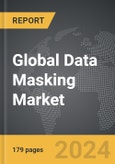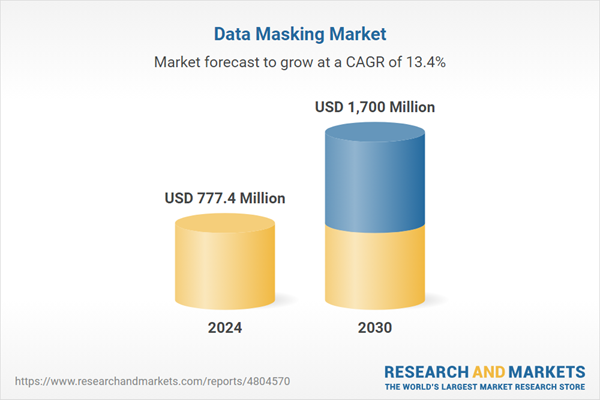The global market for Data Masking was valued at US$777.4 Million in 2024 and is projected to reach US$1.7 Billion by 2030, growing at a CAGR of 13.4% from 2024 to 2030. This comprehensive report provides an in-depth analysis of market trends, drivers, and forecasts, helping you make informed business decisions. The report includes the most recent global tariff developments and how they impact the Data Masking market.
Segments: Business Function (Finance, Marketing & Sales, Operations, Legal, Other Business Functions); Vertical (BFSI, IT & Telecom, Healthcare & Life Sciences, Retail & eCommerce, Other Verticals).
Geographic Regions/Countries: World; United States; Canada; Japan; China; Europe (France; Germany; Italy; United Kingdom; and Rest of Europe); Asia-Pacific; Rest of World.
The analysts continuously track trade developments worldwide, drawing insights from leading global economists and over 200 industry and policy institutions, including think tanks, trade organizations, and national economic advisory bodies. This intelligence is integrated into forecasting models to provide timely, data-driven analysis of emerging risks and opportunities.
Global Data Masking Market - Key Trends and Drivers Summarized
What Is Data Masking and How Does It Secure Sensitive Information?
Data masking is a data security technique used to protect sensitive, private, and confidential data by obscuring it in a way that maintains its usability for purposes such as analytics, testing, and user training. The process involves creating a structurally similar but inauthentic version of the organization's data that can be used in business processes or third-party hands without exposing the actual data. This is achieved by hiding personal identifiers, financial information, and other sensitive data elements from unauthorized access. Data masking techniques can be static, which masks data at rest and produces a sanitized version of the database, or dynamic, which masks data on the fly as queries are made by unauthorized users. In contexts where data needs to be shared with external contractors or used in non-secure test environments, data masking ensures compliance with data protection regulations and mitigates the risk of data breaches.Why Is Data Masking Increasingly Important in Regulatory Compliance?
In the modern digital age, regulatory compliance has become a significant driver for data masking. Legislation such as the General Data Protection Regulation (GDPR) in the European Union, the California Consumer Privacy Act (CCPA), and other global data protection laws have stringent requirements for managing the privacy and security of personal data. Data masking helps organizations comply with these regulations by ensuring that sensitive data is not exposed during processes like software testing, user training, or any scenario where data needs to be utilized without revealing actual details. Compliance with these regulations not only requires protecting data from external threats but also involves securing data from potential internal misuse. By implementing data masking, companies can avoid heavy fines, legal consequences, and damage to reputation associated with data breaches and non-compliance.What Are the Challenges and Technological Innovations in Data Masking?
While data masking is a powerful tool for data security, implementing it effectively presents several challenges. One of the primary challenges is maintaining the balance between data utility and security. Masked data must remain useful for operational or analytical purposes even though it does not reveal any actual sensitive information. Achieving this balance often requires sophisticated algorithms that ensure data integrity and relevance. Another challenge is the complexity of masking data in diverse IT environments that include a wide array of databases and applications. Each environment may require different masking techniques, which can complicate the implementation and management of data masking solutions. However, advancements in technology, particularly in artificial intelligence and machine learning, are improving the capabilities of data masking solutions. These technologies are being used to automate and refine the data masking process, making it more efficient and effective at protecting sensitive information across various data types and environments.What Drives the Growth in the Data Masking Market?
The growth in the data masking market is driven by several factors, key among them being the escalating volume of data generated by businesses and the increasing sophistication of cyber threats. As organizations expand their digital operations, the need to protect critical data assets becomes imperative. The proliferation of data privacy regulations globally also compels organizations to adopt robust data security practices such as data masking. Furthermore, the growing awareness of data breaches and their potential financial and reputational damages has prompted businesses to invest in advanced security measures. Additionally, sectors such as healthcare, finance, and telecommunications, where data sensitivity is particularly high, are rapidly adopting data masking solutions to ensure data privacy and regulatory compliance. These drivers, coupled with technological advancements that enhance the effectiveness and applicability of data masking, are fueling the expansion of the market, highlighting its crucial role in contemporary data security strategies.Report Scope
The report analyzes the Data Masking market, presented in terms of units. The analysis covers the key segments and geographic regions outlined below.Segments: Business Function (Finance, Marketing & Sales, Operations, Legal, Other Business Functions); Vertical (BFSI, IT & Telecom, Healthcare & Life Sciences, Retail & eCommerce, Other Verticals).
Geographic Regions/Countries: World; United States; Canada; Japan; China; Europe (France; Germany; Italy; United Kingdom; and Rest of Europe); Asia-Pacific; Rest of World.
Key Insights:
- Market Growth: Understand the significant growth trajectory of the Finance Function segment, which is expected to reach US$615.5 Million by 2030 with a CAGR of a 15.6%. The Marketing & Sales Function segment is also set to grow at 14.2% CAGR over the analysis period.
- Regional Analysis: Gain insights into the U.S. market, valued at $210.2 Million in 2024, and China, forecasted to grow at an impressive 12.2% CAGR to reach $246.7 Million by 2030. Discover growth trends in other key regions, including Japan, Canada, Germany, and the Asia-Pacific.
Why You Should Buy This Report:
- Detailed Market Analysis: Access a thorough analysis of the Global Data Masking Market, covering all major geographic regions and market segments.
- Competitive Insights: Get an overview of the competitive landscape, including the market presence of major players across different geographies.
- Future Trends and Drivers: Understand the key trends and drivers shaping the future of the Global Data Masking Market.
- Actionable Insights: Benefit from actionable insights that can help you identify new revenue opportunities and make strategic business decisions.
Key Questions Answered:
- How is the Global Data Masking Market expected to evolve by 2030?
- What are the main drivers and restraints affecting the market?
- Which market segments will grow the most over the forecast period?
- How will market shares for different regions and segments change by 2030?
- Who are the leading players in the market, and what are their prospects?
Report Features:
- Comprehensive Market Data: Independent analysis of annual sales and market forecasts in US$ Million from 2024 to 2030.
- In-Depth Regional Analysis: Detailed insights into key markets, including the U.S., China, Japan, Canada, Europe, Asia-Pacific, Latin America, Middle East, and Africa.
- Company Profiles: Coverage of players such as ARCAD Software, CA Technologies, Compuware Corporation, Delphix, Ekobit d.o.o. and more.
- Complimentary Updates: Receive free report updates for one year to keep you informed of the latest market developments.
Some of the 12 companies featured in this Data Masking market report include:
- ARCAD Software
- CA Technologies
- Compuware Corporation
- Delphix
- Ekobit d.o.o.
- IBM Corporation
- Informatica LLC
- Innovative Routines International (IRI), Inc.
- Mentis Technology Solutions, LLC
- Micro Focus International PLC
- Oracle Corporation
- Solix Technologies, Inc.
Tariff Impact Analysis: Key Insights for 2025
Global tariff negotiations across 180+ countries are reshaping supply chains, costs, and competitiveness. This report reflects the latest developments as of April 2025 and incorporates forward-looking insights into the market outlook.The analysts continuously track trade developments worldwide, drawing insights from leading global economists and over 200 industry and policy institutions, including think tanks, trade organizations, and national economic advisory bodies. This intelligence is integrated into forecasting models to provide timely, data-driven analysis of emerging risks and opportunities.
What’s Included in This Edition:
- Tariff-adjusted market forecasts by region and segment
- Analysis of cost and supply chain implications by sourcing and trade exposure
- Strategic insights into geographic shifts
Buyers receive a free July 2025 update with:
- Finalized tariff impacts and new trade agreement effects
- Updated projections reflecting global sourcing and cost shifts
- Expanded country-specific coverage across the industry
Table of Contents
I. METHODOLOGYII. EXECUTIVE SUMMARY2. FOCUS ON SELECT PLAYERSIII. MARKET ANALYSISIV. COMPETITION
1. MARKET OVERVIEW
3. MARKET TRENDS & DRIVERS
4. GLOBAL MARKET PERSPECTIVE
UNITED STATES
CANADA
JAPAN
CHINA
EUROPE
FRANCE
GERMANY
ITALY
UNITED KINGDOM
REST OF EUROPE
ASIA-PACIFIC
REST OF WORLD
Companies Mentioned (Partial List)
A selection of companies mentioned in this report includes, but is not limited to:
- ARCAD Software
- CA Technologies
- Compuware Corporation
- Delphix
- Ekobit d.o.o.
- IBM Corporation
- Informatica LLC
- Innovative Routines International (IRI), Inc.
- Mentis Technology Solutions, LLC
- Micro Focus International PLC
- Oracle Corporation
- Solix Technologies, Inc.
Table Information
| Report Attribute | Details |
|---|---|
| No. of Pages | 179 |
| Published | April 2025 |
| Forecast Period | 2024 - 2030 |
| Estimated Market Value ( USD | $ 777.4 Million |
| Forecasted Market Value ( USD | $ 1700 Million |
| Compound Annual Growth Rate | 13.4% |
| Regions Covered | Global |









